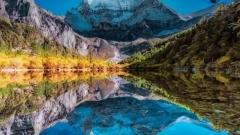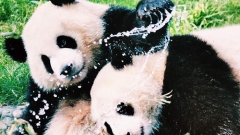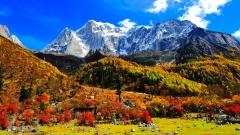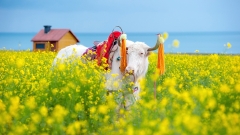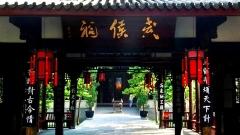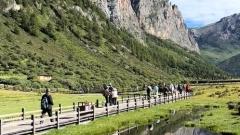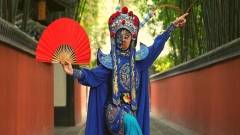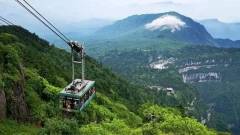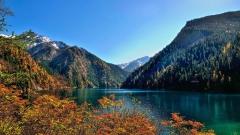Jiuzhaigou National Park – literally “Valley of Nine Villages” – is one of China’s most magical natural landscapes. Tucked into the mountains of northwestern Sichuan, it’s celebrated for iridescent alpine lakes, tiered waterfalls, dense primeval forests and snow-capped peaks. The valley’s mineral-rich waters form lakes in dazzling blues, greens, and turquoises that change with the sky and seasons. This combination of water, forest and mountain scenery has earned Jiuzhaigou global recognition and made it a must-visit destination for nature lovers and photographers.
What Makes Jiuzhaigou Unique
Jiuzhaigou’s core scenic area contains dozens of lakes and waterfalls spread across branching valleys. The landscape is a living palette: calcified travertine terraces, crystalline “haizi” lakes, and waterfalls that plunge across wide shoals. The valley blends natural drama with Tibetan and Qiang cultural touches – monasteries, pastures, and village life — which adds human warmth to the wilderness. According to official descriptions, the protected area comprises roughly 108 lakes, 17 groups of calcified waterfalls, five primeval forests and more than ten snow-capped peaks.
How Jiuzhaigou Is Laid Out: The Y-Shaped Valley System
Jiuzhaigou’s scenic area is typically described as Y-shaped. The three main branches are:
- Shuzheng Valley (lower branch / main entrance) — the primary entry and the largest collection of lakes. It’s home to Shuzheng Lakes and Sparkling Lake.
- Zechawa Valley (left branch) — the longest and highest route, featuring Long Lake and Five-Color Pond.
- Rize Valley (right branch) — contains some of the valley’s most famous spots: Five-Flower (Five-Color) Lake, Pearl Shoal Waterfall and Nuorilang Waterfall.
A lesser-visited Zharu Valley lies to the northeast and offers cultural and pastoral scenes, quiet trails and an intimate window into Tibetan life in the area. Most visitors use the park’s sightseeing buses and boardwalks to move among these valleys.
Jiuzhaigou Recommended Travel Route
The Jiuzhaigou National Park recommended travel route for visitors is as follows: Entrance → Nuorilang Junction → Long Lake → Five-Color Pond → Nuorilang Junction → (hiking 3km, about one hour: Primeval Forest → Sword Rock Waterfall → Swan Lake → Grass Lake → Arrow Bamboo Lake → Panda Lake → Five Flower Lake → Pearl Shoal Waterfall → Mirror Lake → Nuorilang Junction → Nuorilang Waterfall → Rhinoceros Lake → Tiger Lake → Shuzheng Waterfall → Shuzheng Lakes → Sparkling Lake → Double Dragon Lake Waterfall → Reed Lake → Bonsai Lake → Entrance.
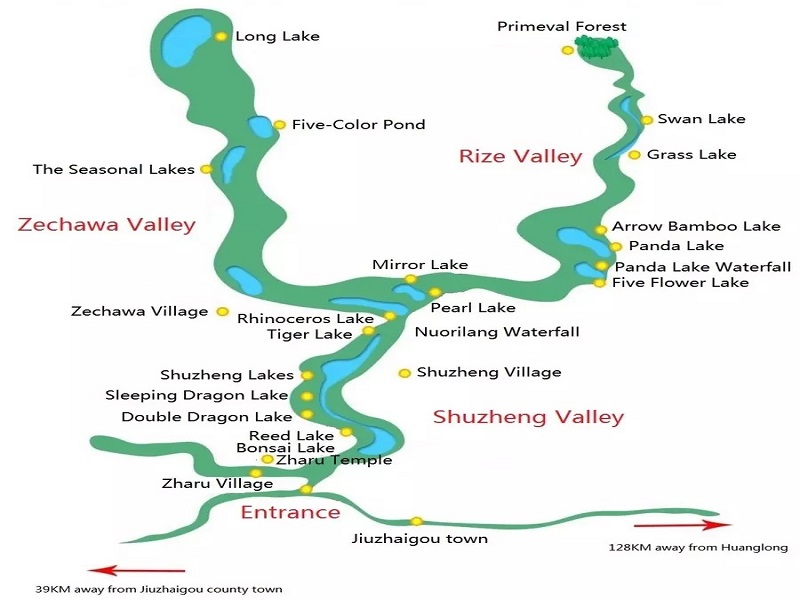
Jiuzhaigou Travel Route
Must-See Highlights of Jiuzhaigou
Shuzheng Lakes and Sparkling Lake
Shuzheng Lakes form the largest lake group in the park and are a striking chain of connected waters that catch the sun like a string of jewels. Sparkling Lake, hidden among dense woodland, truly lives up to its name at sunrise when the water’s surface shimmers. These early-morning scenes are perfect for quiet reflection and photography.
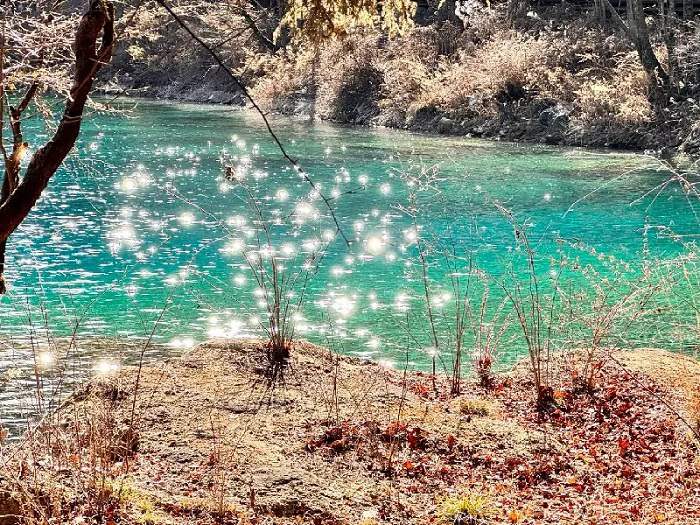
Sparkling Lake
Five-Color Pond (Five-Flower Lake)
One of Jiuzhaigou’s signature sights, Five-Flower Lake dazzles with multiple hues caused by varying mineral content, algae, water depth and reflected foliage. Its crystal surface mirrors the surrounding peaks and trees, producing postcard-perfect images.
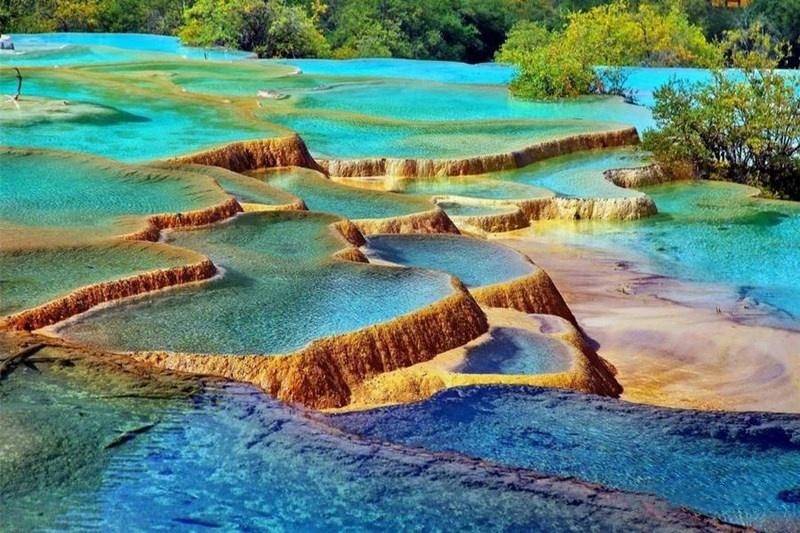
Five-Color Pond
Long Lake
Long Lake is the deepest and largest in the park and sits under a backdrop of snow peaks. Its waters are deep, calm and unbelievably clear — an especially peaceful spot in early morning or late afternoon.
Pearl Shoal and Nuorilang Waterfalls
Pearl Shoal plunges across a broad shoal and drops in a curtain of sparkling droplets — a favorite place for dramatic waterfall photography. Nuorilang is often cited as one of the widest waterfalls in China, presenting a thunderous, panoramic sheet of water; both waterfalls are iconic Jiuzhaigou scenes.
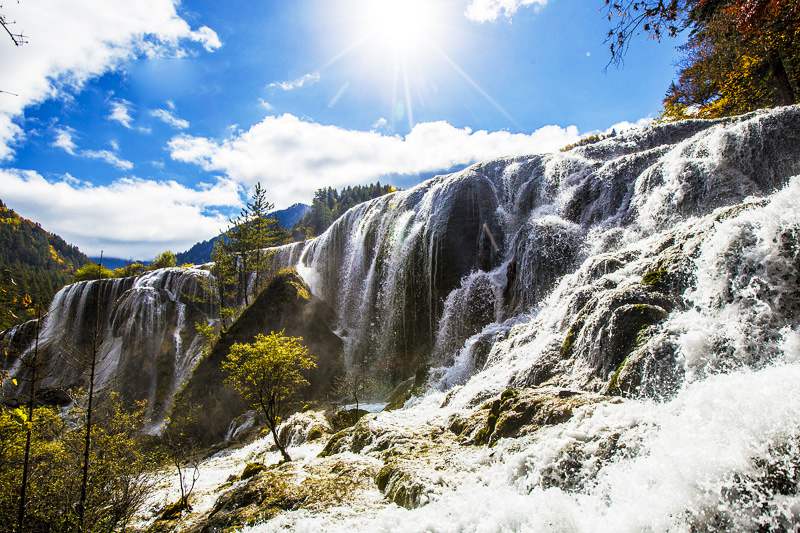
Pearl Shoal
Five-Flower Lake, Mirror Lake and Reed Lake
Each lake has its personality: Five-Flower Lake for color gradations and underwater calcified trees; Mirror Lake for flawless reflections of peaks and forests; Reed Lake for long, tranquil stretches of shoreline and birdlife.
Getting to Jiuzhaigou: Flights, Trains, Buses and Driving
By Air
Most international visitors reach Jiuzhaigou via Chengdu, then fly to Jiuzhai Huanglong Airport (also called Jiuzhaigou Huanglong Airport). The airport offers scheduled flights from major Chinese cities; from the airport it typically takes about 1.5–3 hours by road to reach the Jiuzhaigou scenic area depending on traffic and which transfer option you choose. Shuttle buses run between the airport and major tourist hubs, though schedules can vary with flight arrivals and may stop in late afternoon — taxis or private transfers are common alternatives if you arrive late.
By High-Speed Train
Recent infrastructure upgrades have improved rail access to the region. High-speed rail connections now serve stations that shorten the overland transfer time from Chengdu; for example, trains to stations serving the Jiuzhaigou/Huanglong region can cut travel time significantly and are often combined with a highway transfer to the park. Book train tickets in advance, especially during peak season.
By Bus
Long-distance coach services depart Chengdu’s bus stations to Jiuzhaigou daily. Coaches are budget-friendly but the journey is long (roughly 8–10 hours) and often starts very early. Choose buses cautiously if you are sensitive to long rides at altitude.
By Car / Private Transfer
Driving from Chengdu is popular for travelers who want flexibility. Two main routes – the East Line (via Dujiangyan) and the West Line (via Mianyang) — take about 8–9 hours depending on stops and road conditions. Private transfers or tour companies can provide door-to-door service, often combined with stops at cultural or scenic highlights en route.
Best Time to Visit Jiuzhaigou: Season-by-Season Guide
Autumn (Recommended: Mid-September to Early November)
Autumn is the superstar season. Trees turn fiery reds, oranges and golds, and those colors reflect perfectly in the crystal lakes — this is the peak time for photographers and nature lovers. Expect crowds and higher prices during mid-October national holidays.
Spring (March to May)
Spring brings melting snow, swelling streams and a blanket of wildflowers. Weather is fresh but can be changeable; trails may still be wet, so prepare for mud and mixed temperatures.
Summer (June to August)
Summer is cool compared with lowland China — perfect for heat-escape travelers — and waterfalls are at their fullest. Rain and afternoon clouds are common, producing dramatic misty scenes, but also occasional visibility issues.
Winter (December to February)
Winter transforms Jiuzhaigou into a snowy fantasy. Some areas may close or have limited access, but the quiet, frosted scenery is unique. If you visit in winter, bring heavy cold-weather gear and confirm which attractions are open.
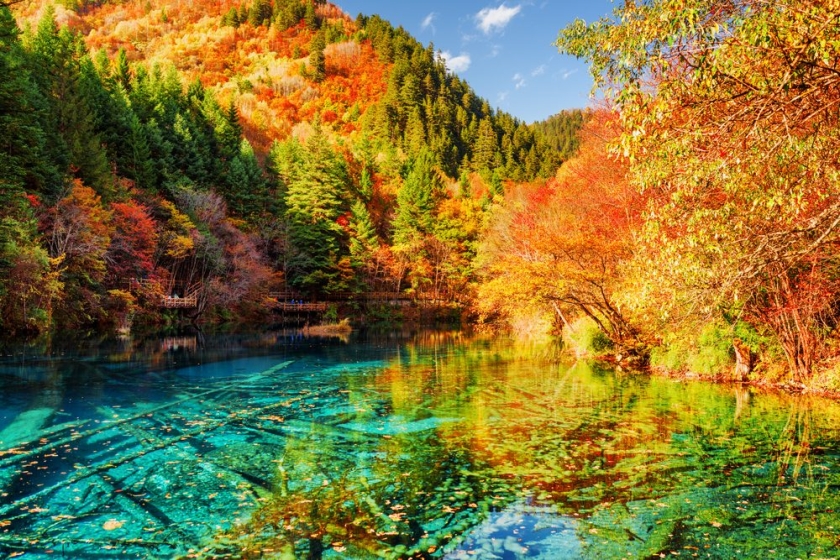
Jiuzhaigou
Jiuzhaigou Suggested Itineraries
7-Day 6-Night Chengdu, Jiuzhaigou & Mount Emei Tour $ From 610/Pax
Day 1: Chengdu Airport/Train Station Pick-up – Hotel Check-in – Free Time in Downtown Chengdu
Day 2: Chengdu – Chengdu Research Base of Giant Panda Breeding – High-Speed Train to Jiuzhaigou – Hotel Check-in
Day 3: Full-Day Tour of Jiuzhaigou Scenic Area
Day 4: Jiuzhaigou – Huanglong Scenic Area – High-Speed Train to Chengdu – Hotel Check-in
Day 5: Chengdu – Huanglongxi Ancient Town – Leshan Giant Buddha – Mount Emei Hotel Check-in
Day 6: Mount Emei Full-Day Tour – Evening Return to Chengdu
Day 7: Airport/Train Station Transfer – End of Tour
- Brief itinerary:Chengdu Research Base of Giant Panda Breeding, Jiuzhaigou, Huanglong Scenic Area, Leshan Giant Buddha, Mount Emei
- ⇒ Click here to see detailed Itinerary
Photography & When to Shoot at Jiuzhaigou
- Golden hour (sunrise / sunset): Best light for reflections and warm tones.
- Autumn mornings: Clear skies and still water offer perfect mirror shots.
- After rain: Waterfalls and forests look vivid; mist can produce dramatic atmospheres.
- Avoid high-noon: Harsh overhead light flattens colors and creates glare on water.
Respect park regulations about tripods and drones — drones are usually banned in protected areas.
Jiuzhaigou Practical Tips: Health, Clothing, and Park Rules
Altitude and Health
Jiuzhaigou sits between roughly 2,000 and 4,800 meters elevation in places. Most visitors experience the park at 2,000–3,000 meters — altitude sickness is possible. Drink plenty of water, rest on arrival, avoid heavy exertion the first day, and carry altitude sickness medication if you are prone or have lung/cardiac conditions. A brief health check before travel is a good idea.
Clothing and Packing
- Layered clothing for wide day–night temperature swings.
- Waterproof jacket and quick-dry clothing for summer rain.
- Warm hat, gloves and insulated jacket for autumn/winter mornings.
- Good walking shoes with grip for boardwalks and steps.
- Sun hat and high-SPF sunscreen — high-altitude sun is intense.
- Basic first-aid, personal meds, and motion-sickness remedies for winding roads.
Park Rules & Environmental Etiquette
Jiuzhaigou is a protected nature reserve. Stick to boardwalks and marked trails, don’t pick vegetation, and never feed wildlife. Smoking and loud music are typically prohibited within scenic areas — respect rules and local culture to keep this fragile ecosystem intact.
Accessibility & Family Travel
The park has long boardwalks and sightseeing buses, but some viewpoints require stairs and uneven surfaces. Families and older travelers can still enjoy the main lakes and waterfalls using designated paths and bus connections. Bring snacks, water, and plan rest breaks — facilities exist at major parking and entrance areas.
Safety and Emergency
- Emergency numbers: Keep local emergency numbers and your hotel contact handy.
- Weather: Mountain weather changes fast; carry waterproof layers and a warm mid-layer.
- Roads: Mountain roads to Jiuzhaigou can be narrow and winding. Drive carefully or use experienced drivers.
- Insurance: Travel insurance covering emergency evacuation and medical treatment at altitude is recommended.
Local Culture and Respectful Travel of Jiuzhaigou
Jiuzhaigou is within the lands of Tibetan and Qiang communities. When visiting villages, monasteries or religious sites:
- Ask permission before photographing people.
- Dress modestly near religious sites.
- Observe quiet zones and don’t disturb ritual offerings.
- Buy local handicrafts responsibly to support the local economy.
Sustainable Travel: How You Can Help Protect Jiuzhaigou
- Stick to marked trails and boardwalks.
- Carry out any litter and avoid single-use plastics where possible.
- Avoid disturbing wildlife and plants.
- Use local guides and services that prioritize conservation-minded tourism.
- Respect park visitor limits and time windows — controlled access helps preserve fragile scenery for future generations.
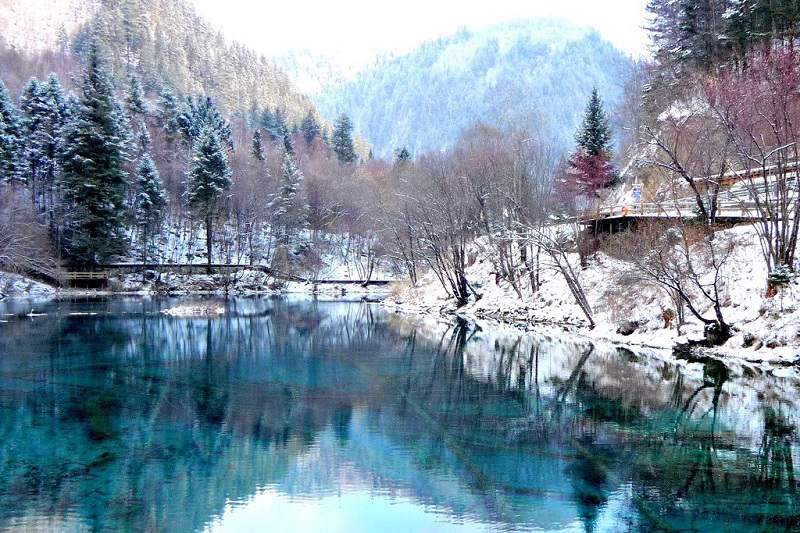
Jiuzhaigou Winter
Jiuzhaigou Frequently Asked Questions (FAQ)
Q: Do I need a guide to visit Jiuzhaigou?
A: Guides are optional for the main routes but helpful for cultural interpretation, choosing the best viewpoints and handling logistics, especially if you include Zharu Valley or want local insights.
Q: Are there accommodations near the park?
A: Yes — Songpan and nearby towns have hotels and guesthouses. There are also accommodations near Huanglong and at the airport area for early/late flights.
Q: Is Jiuzhaigou wheelchair accessible?
A: Major boardwalks and some viewpoints are accessible, but many paths have stairs or uneven surfaces. Contact park authorities or your tour operator for current accessibility details.
Q: When are crowds the biggest?
A: Golden weeks — especially China’s National Day (first week of October) — see peak crowds. Mid-October is spectacular for color but expect more visitors. Consider shoulder-season visits for fewer people.
Packing Checklist of Jiuzhaigou
- Sturdy walking shoes
- Layers: thermal base, fleece mid-layer, waterproof shell
- Sun protection: hat, sunglasses, SPF 30+ sunscreen
- Reusable water bottle and small snacks
- Personal medication and altitude tablets (if prescribed)
- Camera, tripod (check rules), spare batteries and memory cards
- Lightweight daypack and rain cover
Why Jiuzhaigou Should Be on Your Bucket List
Jiuzhaigou rewards slow travel and curiosity. Whether you’re after mirror-like lakes, thunderous waterfalls, autumnal color or quiet cultural encounters in Zharu Valley, planning your trip with an experienced operator makes the experience smoother and more meaningful.
If you’d like help planning a Jiuzhaigou trip tailored to international travelers — including private transfers, local guides, accommodation, and flexible itineraries timed for optimal light and crowds — China Dragon Travel offers customized itineraries and full-service arrangements that handle transport, permits and local logistics so you can focus on enjoying the fairyland. Contact China Dragon Travel for bespoke Jiuzhaigou packages and practical support for international guests.



